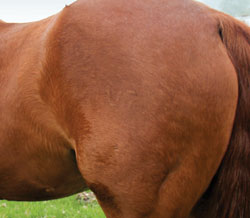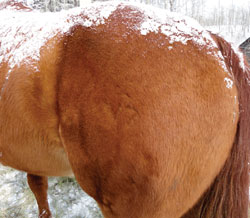
|
In the last few years there has been a shift in the equine world. Some horse owners have decided that hot iron branding is “cruel”. Incorrectly done, they’re right. However, hot branding a horse properly results in little discomfort for them and a whole lot of peace of mind for you.
Why should you brand your horse?
Last year in Alberta alone, about 100 horses were reported stolen. And don’t think these horses are only rustled from big pastures far from the home quarter. Some very expensive performance horses were stolen from secure barns. They were walked right out of their home pastures or barns and into a waiting trailer, never to be seen again. Whether your horse is a treasured kids pony or a high performance horse, statistics show that if a stolen horse is unbranded, you will rarely know their fate.
Cam Camden of the Alberta Livestock Identification Services says, “Without a registered brand on their horse, an owner has a limited chance of recovery.”
Distraught owners approach the RCMP and brand inspectors with a mitt-full of photos for identification of their unbranded horses. But, as Camden says, “Do you have any idea how many bay mares are in Alberta? And people don’t even agree on what colour ‘bay’ is.”
To dispel the myths and to learn from the savvy, I recently asked a number of experienced cowboys for their advice. Collectively, they have branded an incalculable number of horses. Here’s what works for them:
Stan Jacobs
Cow Boss, Douglas Lake Ranch
Douglas Lake, B.C.
“We brand them as yearlings, about 10 months of age is when we do the majority of them. We spend about eight or nine days halter breaking, getting them used to the barn, picking up their feet and then the last thing we do is brand them, castrate the stud colts and pull wolf teeth. Our vet comes and sedates them so they’re out cold. They go to sleep and when they wake up it’s a done deal. We just spent a week teaching them that we’re not real bad people so we don’t want to rope them and what not and that be their last association with us before we turn them out until they’re two-year-olds,” states Stan.
Branding Mature Horses
“We have a setup where we can swing two wooden gates together that have some give, but solid enough that a horse can’t stick a leg through. We’ll stand the horse in there. Not to squeeze them, but to prevent them from jumping back and forth. They’re broke, so they stand and accept that. Then we take a cold iron and just keep touching it to the shoulder a few times so the horse gets used to contact; so it doesn’t jump and flinch or cause them to fight. Once we get them relaxed to the steady rhythm and touch of the cold iron then we just replace the cold iron with the hot iron and bam, it’s done. Generally before the horse even realizes it’s branded, it’s done. Horses brand way easier than a cow does; their hide is way thinner.”
“The other thing you can comment to these guys that don’t live in the real world; in B.C. any livestock that runs on Crown range has to be branded. It’s not an option; it’s not an ‘Oh gee, we don’t wanna burn our widdle animals’ – it’s against the law to turn unbranded livestock onto Crown range.”
How to Read a Brand
Brands are read from top to bottom, left to right.
There are six horse brand locations:
LJ….Left Jaw
RJ….Right Jaw
LS….Left Shoulder
RS….Right Shoulder
LH….Left Thigh (Hip)
RH….Right Thigh (Hip)
In 2011, B.C. added two more horse brand locations; right or left upper back area; freeze branding only.
How to Register a Brand
British Columbia
www.ownership-id.com
4 Year Fee……..$112
Renewal Fee…. $84
Alberta
www.lis-alberta.com
4 Year Fee……………not available
Lifetime Brand Fee…$231
Saskatchewan
www.agriculture.gov.sk.ca/lims/brands
4 Year Fee……………$25
Lifetime Brand Fee…$200
Vern Ballantyne
Rancher
Unity, Sask.
“I’ll get a stick, like a chunk of 2 x 4 and just keep touching where I’m going to brand them until they get used to it and it’s not bothering them. Then I put the hot iron on there and it doesn’t need to be left very long on the horse. By the time they flinch away from it, you’re done. I have hobbled them but generally just tie them up; I’ve never had one in a chute. Before you do it though, they ought to be standing there comfortable. And by the time they’re uncomfortable, it’s finished.”
Bronc Twan

|
Cow Boss, Alkali Lake Ranch
Alkali Lake, B.C.
“Branding horses is very quick; they’re thin-skinned and you just got to touch them and it’s there. You don’t hold the iron on.”
“Here, the colts were weaned in the fall. By January there are no flies around so we’d bring the colts in and halter break them. We’d have them in the barn so we’d clip out a little patch on the left hip where the brand was going and we’d touch the thin branding iron on there. The colts would take one little jump ahead and boom, it was done. We’d do them standing up right in the stall. We clip the patch right down; it makes everything so much quicker and cleaner and in January there’s no infection around. You’re putting the brand on little baby colts so by the time they grow up the brand would be about 3?or so.”
“Theft” is the reason why the Alkali crew brand their horses. “How many bay horses are there in the country? How many sorrels? We live right beside a big reserve and there’s 200?–?300 head of horses there. There are times when horses just get mixed you know, and if you have a bunch of yearlings and they have a bunch of yearlings, and there’s a bunch of straight bays or sorrels… it’s just easier to not have the argument. It’s proof of ownership.”
The Alkali horse brand is a single iron that measures 2?½” x 2″.
Tom Reardon
Pasture Manager
Meyronne, Sask.
“I take two lengths of 1 x 4 wood and stack them with the top board stepped back about half an inch and nail them together. I’ll stand the horse in a stall and push on the hip a time or two with this board. When you push on a horse, they push back. So that’s what happens; I’m pushing with the 1 x 4’s and he’s pushing back so essentially he’s leaning into it. When you push a board against a horse’s hide it makes a bit of a bubble at the top,” he says. “I’ve found that if I use a stepped-back board, the hide “bubble” is absorbed by the ½? gap at the top of the boards and the irons will slide flat onto their hide.”
“I’ll push the board against them a few times while the iron is heating then I just slide the hot iron down the board and the brand goes on straight and level. There’s no commotion, no kick, no nothing. By the time he noticed it, it’s over and done with. I’ve never had a problem. I stand them in one stall, and I’ll stand in the stall beside them to brand.” c















